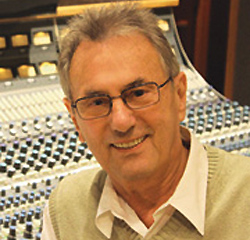
How do you handle leakage? Do you worry about it?
No, I don’t. Actually leakage is one of your best friends because that’s what makes things sometimes sound so much bigger.
The only time leakage is a problem is if you’re using a lot of crap mics. If you get a lot of leakage into them, it’s going to sound like crap leakage. But if you’re using some really good microphones and you’re get some leakage, it’s usually good because it makes things sound bigger.
I try to set everybody, especially in the rhythm section, as close together as possible. I come from the school when I first started where there were no headphones. Everybody had to hear one another in the room, so I still set up everybody up that way. Even though I’ll isolate the drums, everybody will be so close that they can almost touch one another.
What’s the hardest thing for you to record?
Getting a great piano sound. You know, piano is a difficult instrument and to get a great sound is probably one of the more difficult things for me. The human voice is another thing that’s tough to get. Other than that, things are pretty simple.
The larger the orchestra the easier it is to record. The more difficult things are the 8 and 9 piece things, but I’ve been doing it for so long that none of it is difficult any more.
What mics do you use on piano?
I’ve been using the M 149s along with old Studer valve preamps on piano, so I’m pretty happy with it lately. I try to keep them up as far away from the hammers as I can inside the piano. Usually one captures the low end and the other the high end and then I move them so it comes out as even as possible.
It sounds like you’re a minimalist. You don’t use much EQ or compression.
No, I use very little compression and very little EQ. I let the microphones do that.
What’s you’re setup for horns?
I’ve been using a lot of (Neumann) 67s. On the trumpets I use a 67 with the pad in and I keep them in omnidirectional. I get them back about 3 or 4 feet off the brass. On saxophones I’ve been using M 149s. I put the mic somewhere around the bell so you can pick up some of the fingering. For clarinets, the mic should be somewhere up near the fingerboard and never near the bell.
How do determine the best place in the studio to place the instruments?
I’m working at Capital now and I’ve worked here so much that I know it like the back of my hand so I know exactly where to set things up to get the best sound. It’s a given for me here. My setups stay pretty much the same. I try to keep the trumpets, trombones and the saxes as close as possible to one another so they feel like a big band. I try to use as much of the room as possible.
I want to make certain the musicians are as comfortable as they can be with their setup. That means that they have clear sightlines to each other and are able to see, hear and talk to one another. This means having all the musicians as close together as possible. This facilitates better communication among them and that, in turn, fosters better playing.
I start by setting members of the rhythm section up as close to each other as possible. To get a tight sound on the drums and to assure no leaking into the brass or strings’ mics, I’ll set the drums up in the drum booth. Then I’ll set the upright bass, the keyboard and the guitar near the drum booth so they all will be able to see and even talk easily to each other.
If there’s a vocalist, 90 percent of the time I’ll set them up in a booth. Very few choose to record in the open room with the orchestra, although Frank Sinatra and Natalie Cole come to mind.
If you had only one mic to use, what would it be?
A 67. That’s my favorite mic of all. I think it works well on anything. You can put it on a voice or an acoustic bass or an electric guitar, acoustic guitar, or a saxophone solo and it will work well. It’s the jack of all trades and the one that works for me all the time.
Bobby Owsinski is an author, producer, music industry veteran and technical consultant who has written numerous books covering all aspects of audio recording. For more information be sure to check out his website and blogs. Get the second edition of The Recording Engineer’s Handbook here.
